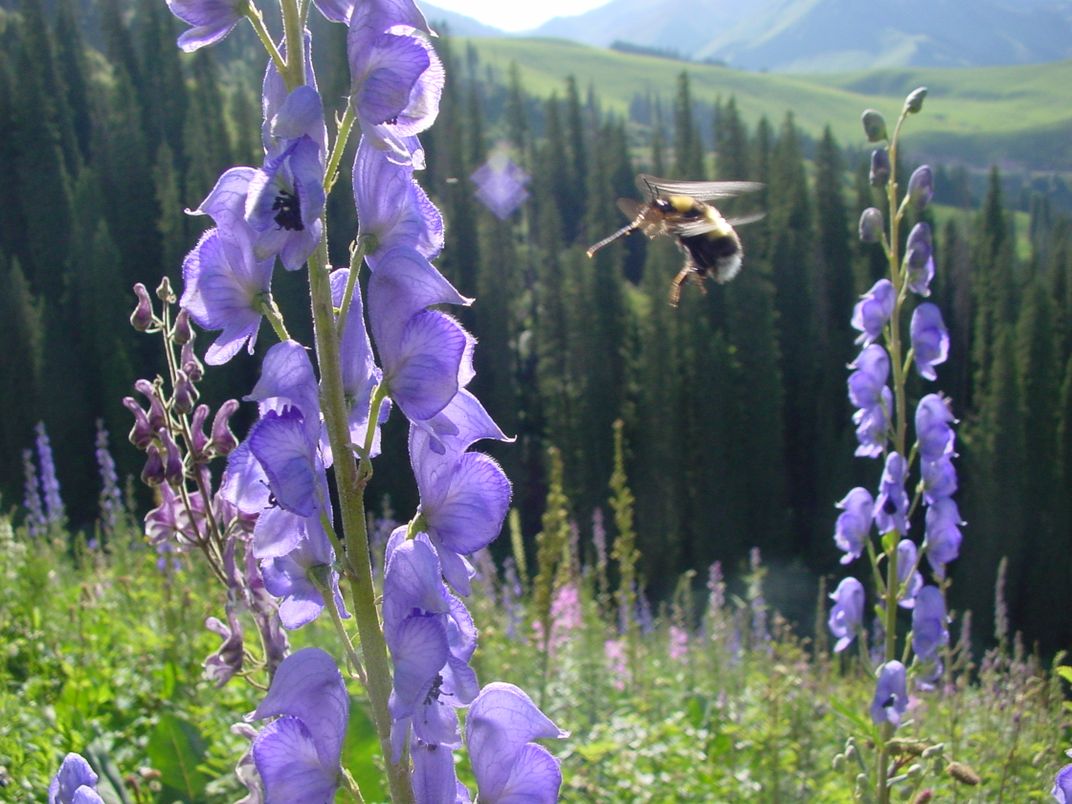Bumblebees Can Fly Into Thin Air
Once thought to be unimpressive fliers, bumblebees may be able to summit Mount Everest, new research suggests
/https://tf-cmsv2-smithsonianmag-media.s3.amazonaws.com/filer/72/44/7244a547-707a-48cf-89a6-bcebcd7d09d0/bombusflavifrons.jpg)
With chubby bodies and small wings, bumblebees don't have a reputation for their aerial skills. Their clumsy manner led some scientists to erroneously suggest that their flight even defied aerodynamics. But, what they lack in elegance, they make up for in altitude. According to new research, bumblebees could, in theory, summit Mount Everest.
The idea that bees can become expert mountaineers seems illogical. "You climb a mountain, and it’s cold and hard to breathe. There’s no oxygen. For flying insects, it’s even worse," says Michael Dillon, an ecologist at the University of Wyoming in Laramie. "The air density is reduced, so it’s hard to actually produce forces by flapping your wings. There’s just fewer molecules in the air to push against."
But according to Dillon and his colleague Robert Dudley, an ecologist at the University of California at Berkeley and the Smithsonian Tropical Research Institute in Panama, we'd be wise to not underestimate bees. The pair looked at the flight limits of bumblebees and published their results in Biology Letters today. "Much to our surprise, [bees] can fly much higher than we thought they would be able to," says Dillon.
Flying insects are hard to study in the field, and scientists don't know a lot about the extreme limits of bee flight. They have some clues though: Carpenter bees (Xylocarpa varipuncta) native to the southwestern United States can hover in low air density environments characteristic of high altitudes. Tropical orchid bees can lift twice their weight while hovering, another indicator that bees have a little more flying skills than just the ability to flit from one flower to another.
Those bees are tropical or lowland species, while bumblebees are common denizens of Alpine hiking trails from the American Rockies to the Andes. "They seem to be really good at hanging out at high elevations," says Dillon. So the researchers wondered, how hard is it for bees to actually fly around up there?

In the mountains of western China, the researchers captured six local male bumblebees (Bombus impetuosus) in the wild at around 10,660 feet. They stuck the bees in a hypobaric chamber, and gradually sucked air out, simulating higher elevation environments with reduced oxygen and air density. "Just by pumping air out, we can reduce the total barometric pressure which would be like carrying the bee up the mountain," says Dillon.
They observed the bees' behavior, recorded sound to calculate their wing beat rhythms, and analyzed wing motion from video footage. The average bumblebee could still successfully hover at about 26,000 simulated feet, and two bees flew higher than 29,527 simulated feet—that's about 500 feet above the summit of Mount Everest.

To reach such dizzying altitudes, any flying organism (or even a helicopter) basically has two options: beat their wings faster or increase their wing stroke amplitude, the angle through which they beat their wings. Just flapping their little wings faster would likely be harder for a bee because they beat their wings in a fairly unique way, so the best option for the bee is take wider strokes.
"They almost look like they’re sort of treading water in some sense, says Dillon. "They beat their wings through a wider arc so that each time they move their wings through that arc they’re actually pushing their wings against more molecules than they would otherwise." He notes that there are other more subtle changes to wing motions that could allow them to increase the force that their wings produce as well.
Let's take a step back though—the experiment involved bees in essentially a jar, with air pressure and oxygen levels changing around them. But what of the wind, the cold, the snow, and the myriad of other factors that make ascending a mountain so hazardous? It turns out that bees are hardy creatures—Dillon has found bumblebees as high as 16,000 feet. At high elevations where "there are just the heads of flowers peaking out of the snow, bumblebees zip up there and visit these flowers," says Dillon. The fact that they were flying speaks to the bees' ability to adapt to such altitude changes.
So, why do bees have this ability? All flying animals cope with altitude in different ways, but they usually have an excess flight performance that allows them to do so. For bees and other insects, "that excess flight performance is really useful for things like escaping from predators," says Dillon. With birds patrolling the skies and spiders lurking on flowers, it's a dangerous world out there for a bee.
Bees also need to carry pollen and nectar back to the hive. "Bees may be an unusual case in that their need to lift heavy loads could confer a secondary advantage of giving them greater altitude range. They would not necessarily be able to do both at the same time—at least not to the same degree," says Richard Bomphrey, a biologist at the University of London's Royal Veterinary College in the UK. In essence, the bees' ability to trek up a mountain could be just a byproduct of traits evolved to enhance pollen-gathering.
Understanding the flight limits of bees and other insects and animals could help scientists predict the ways climate change might impact their ranges. Aside from giving us a better understanding of insect ecology, flight studies inform engineers trying to build tiny flying robots—that could one day, for example, monitor traffic or survey a disaster site—about how best to mimic bees and other bugs.
"This paper is an elegant demonstration of how flying animals can enhance their aerodynamic forces through simple kinematic changes," says Bomphrey. Engineers, he suggests, could build on the same strategy. So in more ways than one, these findings take the flight of the bumblebee to a whole new level.
/https://tf-cmsv2-smithsonianmag-media.s3.amazonaws.com/accounts/headshot/Screen_Shot_2014-01-27_at_12.05.16_PM.png)
/https://tf-cmsv2-smithsonianmag-media.s3.amazonaws.com/accounts/headshot/Screen_Shot_2014-01-27_at_12.05.16_PM.png)